AI transcription has revolutionized the way we convert speech to text. At ScriberJoy, we’ve seen firsthand how this technology can save time and boost productivity.
However, achieving accurate AI transcription isn’t always straightforward. This post will guide you through the key factors and best practices to maximize your transcription accuracy.
How AI Transcription Works
AI transcription has revolutionized the conversion of speech to text. This technology uses advanced algorithms to process audio input and transform it into written text transcriptions. Let’s explore the inner workings of AI transcription and why it has become the preferred choice for many professionals.
The AI Transcription Process
AI transcription begins with speech recognition. The software analyzes audio waveforms of spoken words and matches them to a vast database of known sounds. These sounds are then interpreted as phonemes (the smallest units of speech). The AI uses complex statistical models to predict which words these phonemes represent.
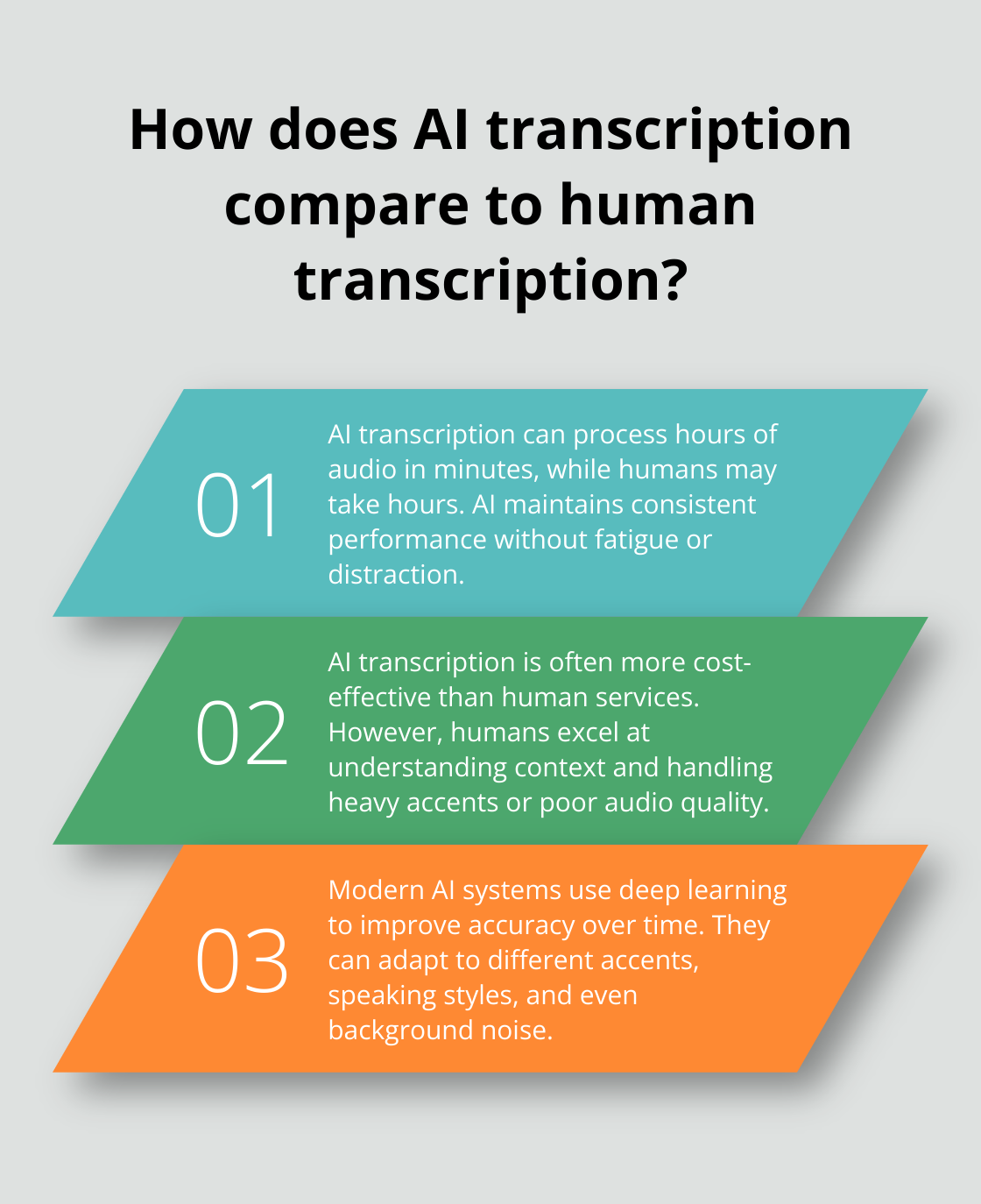
Modern AI transcription stands out due to its use of deep learning. Unlike older systems that relied on rigid rules, today’s AI learns from vast amounts of data. This allows it to improve its accuracy over time and adapt to different accents, speaking styles, and even background noise.
AI vs. Traditional Transcription
AI offers several advantages over traditional human transcription:
- Speed: AI can transcribe hours of audio in minutes, while a human might take hours for the same task.
- Consistency: AI doesn’t get tired or distracted, maintaining steady performance across long recordings.
- Cost-effectiveness: AI transcription often comes at a fraction of the cost of human transcription services.
However, human transcriptionists still excel at understanding context, handling heavy accents, or transcribing poor quality audio. That’s why some services (like ScribeJoy for medical transcription) combine AI with human verification to achieve high accuracy rates.
Recent Advancements
Natural Language Processing (NLP) has significantly improved AI transcription accuracy. Modern systems now understand context, punctuation, and even speaker intent. This means they can differentiate between homophones (words that sound the same but have different meanings) based on the surrounding words.
Speech recognition has also made significant progress. The latest models can handle:
- Multiple speakers
- Background noise
- Overlapping speech
Some systems can even identify different speakers and label them in the transcript automatically.
These advancements have made AI transcription a viable option for industries with strict accuracy requirements, such as healthcare and legal services. As we move forward, the key to achieving accurate AI transcription lies in understanding and optimizing various factors that influence its performance.
What Makes AI Transcription Accurate?
AI transcription accuracy depends on several key factors working in tandem. Understanding these elements helps users achieve reliable results and make the most of this technology.
The Foundation: High-Quality Audio Input
Clear, crisp audio with minimal background noise forms the bedrock of accurate AI transcription. A study by the International Journal of Speech Technology found that improved audio quality can increase transcription accuracy by up to 20%.
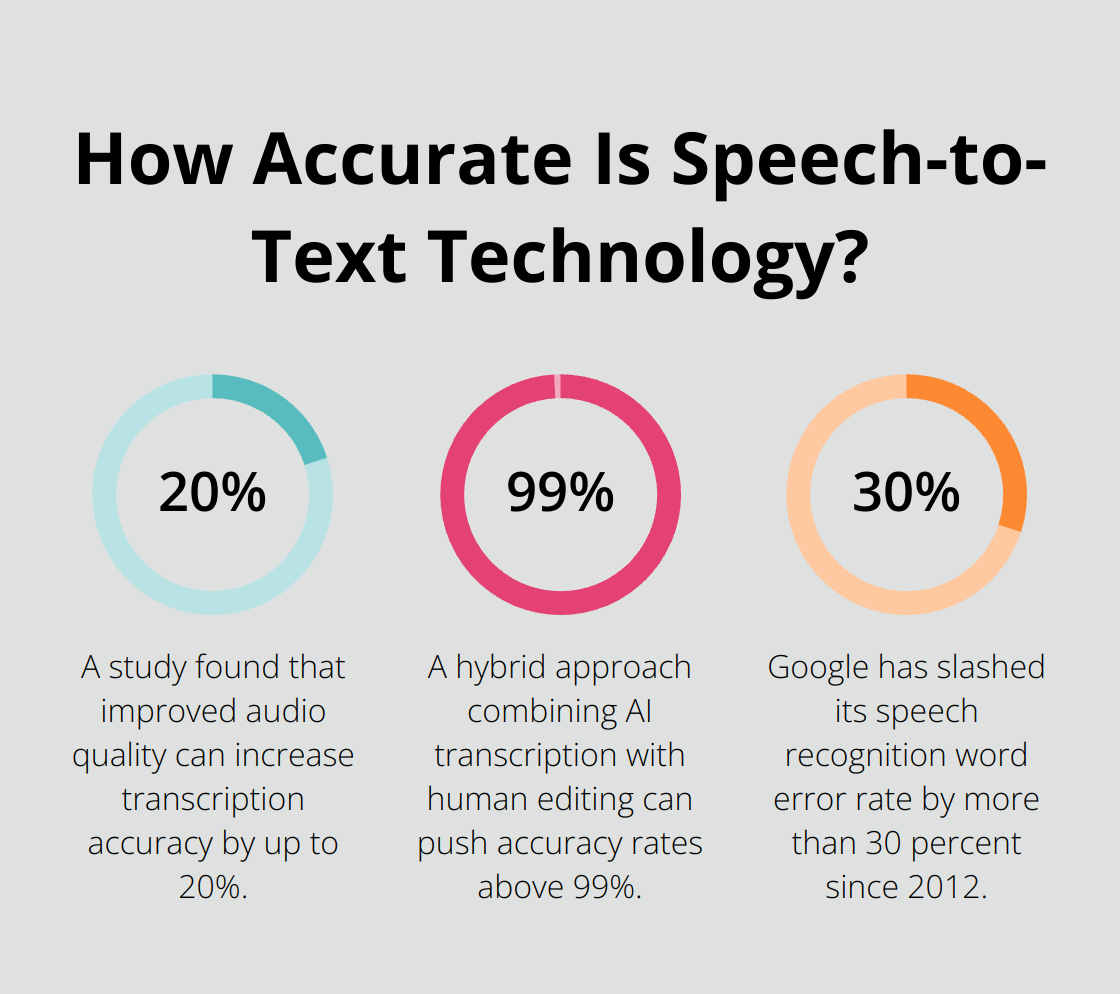
To optimize your audio:
- Invest in a high-quality microphone
- Choose a quiet recording environment
- Speak clearly at a consistent volume
- Avoid overlapping speech in multi-speaker scenarios
Specialized AI Models for Industry-Specific Terminology
Generic AI models often struggle with specialized vocabulary. Industry-specific models prove essential for accurate transcription in fields like healthcare, legal, and finance.
However, it’s important to note that AI transcription models struggle to maintain accuracy outside ideal conditions, especially with background noise, accents, or multiple speakers. This specialization can help improve accuracy with complex terms, but challenges remain in real-world scenarios.
The Human Element: Verification and Editing
While AI has made significant progress, human verification remains vital for achieving the highest levels of accuracy. A hybrid approach, combining AI transcription with human editing, can push accuracy rates above 99%.
This method excels at:
- Interpreting complex accents or dialects
- Understanding context-dependent phrases
- Correcting rare or newly coined terms
Many top transcription services employ this hybrid model to deliver superior results.
Continuous Learning and Improvement
The most effective AI transcription systems evolve and improve over time. This process involves:
- Regular updates to the AI model with new data
- Fine-tuning based on user corrections
- Adaptation to evolving language patterns and new terminology
For example, Google’s speech recognition technology has shown significant improvement, with the company slashing its word error rate by more than 30 percent since 2012.
These key factors significantly enhance AI transcription accuracy. The next section will explore best practices to maximize the performance of your AI transcription tools and achieve optimal results.
Optimizing AI Transcription Accuracy
AI transcription accuracy depends on several key factors. We’ll explore the best practices to maximize the performance of your AI transcription tools and achieve optimal results.
Master Your Audio Recording
High-quality audio forms the foundation of accurate transcription. Invest in a good dictation microphone (it doesn’t have to be expensive, but avoid built-in laptop or smartphone mics). Position the microphone 6-12 inches away from the speaker.
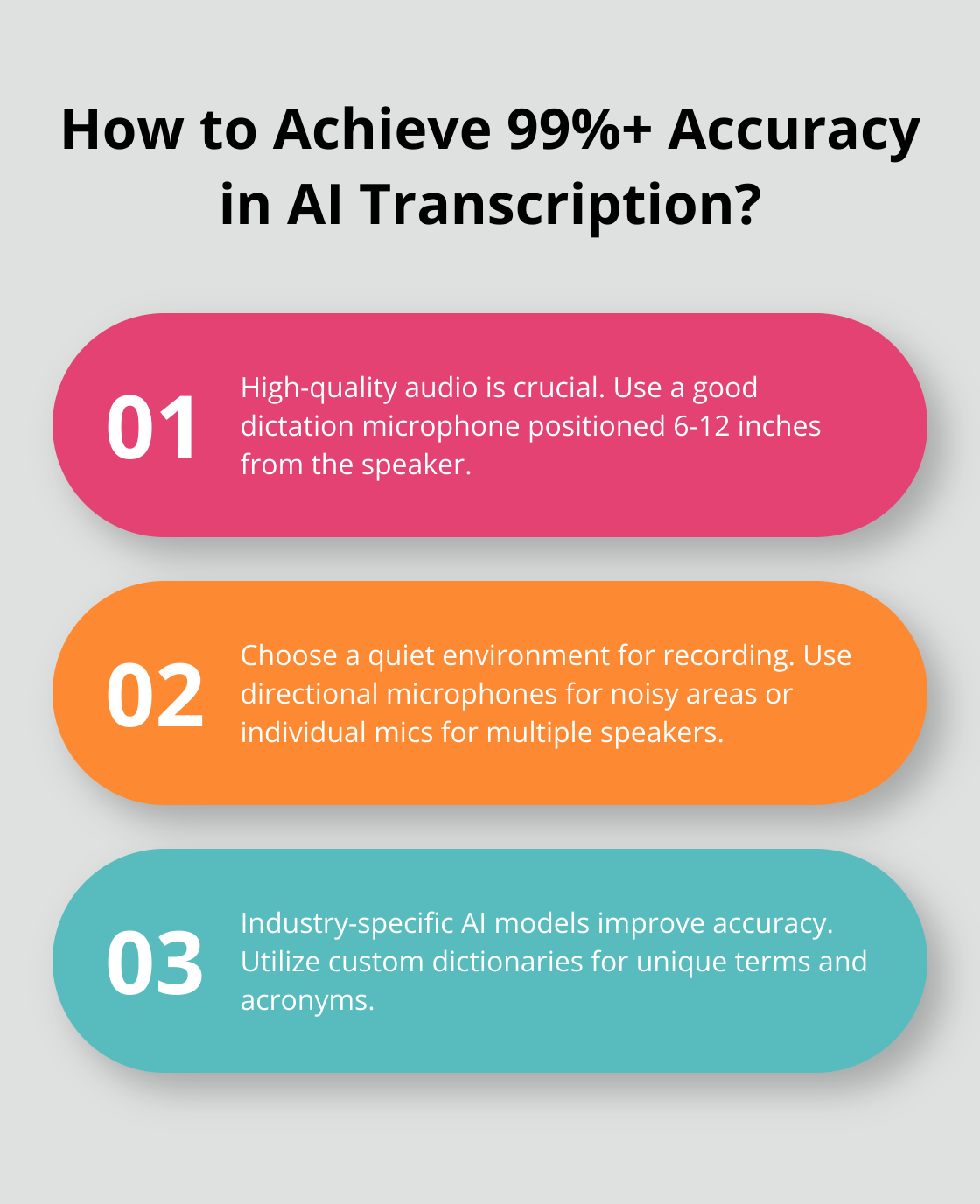
Choose a quiet environment for recording. If you’re in a noisy area, use a directional microphone to focus on the speaker’s voice. For multiple speakers, use individual mics or a high-quality omnidirectional microphone.
Speak clearly and maintain a consistent volume. Try to maintain a natural, conversational pace. If you’re interviewing someone, brief them on these best practices beforehand.
Leverage Industry-Specific Tools
Generic AI models often struggle with specialized terminology. If you work in fields like healthcare or law, look for transcription services that offer industry-specific models. These models are trained on relevant vocabulary and can significantly improve accuracy.
Some services allow you to upload custom dictionaries or glossaries. Use this feature to include unique terms, acronyms, or names specific to your field or organization.
Keep Your Software Updated
AI transcription technology evolves rapidly. Always use the latest version of your transcription software. These updates often include improvements to the AI model, bug fixes, and new features that can enhance accuracy.
For cloud-based services, updates are usually automatic. For desktop applications, enable automatic updates or check for new versions regularly.
Embrace Human Verification
While AI has made tremendous strides, human verification remains essential for achieving the highest levels of accuracy. Implement a hybrid approach that combines AI transcription with human editing.
This approach can push accuracy rates above 99%. Human editors can catch nuances that AI might miss, interpret complex accents or dialects, and understand context-dependent phrases.
Set up a two-step process: first, run your audio through AI transcription, then have a human editor review and refine the results. This approach balances speed and accuracy, giving you the best of both worlds.
Fine-Tune Your Process
Every transcription project is unique. Pay attention to what works well and what doesn’t in your specific context. Are there certain types of audio that consistently produce better results? Do some speakers or accents require more human editing?
Use these insights to refine your process over time. You might find that certain pre-processing steps (like noise reduction or audio normalization) improve your results. Or you might discover that breaking longer audio files into smaller chunks leads to better accuracy.
Final Thoughts
Accurate AI transcription has become an essential tool for professionals across various industries. High-quality audio input and specialized AI models tailored to specific industries significantly improve the handling of complex terminology. The combination of AI efficiency with human verification pushes accuracy rates to new heights, making AI transcription viable even for fields with strict requirements.
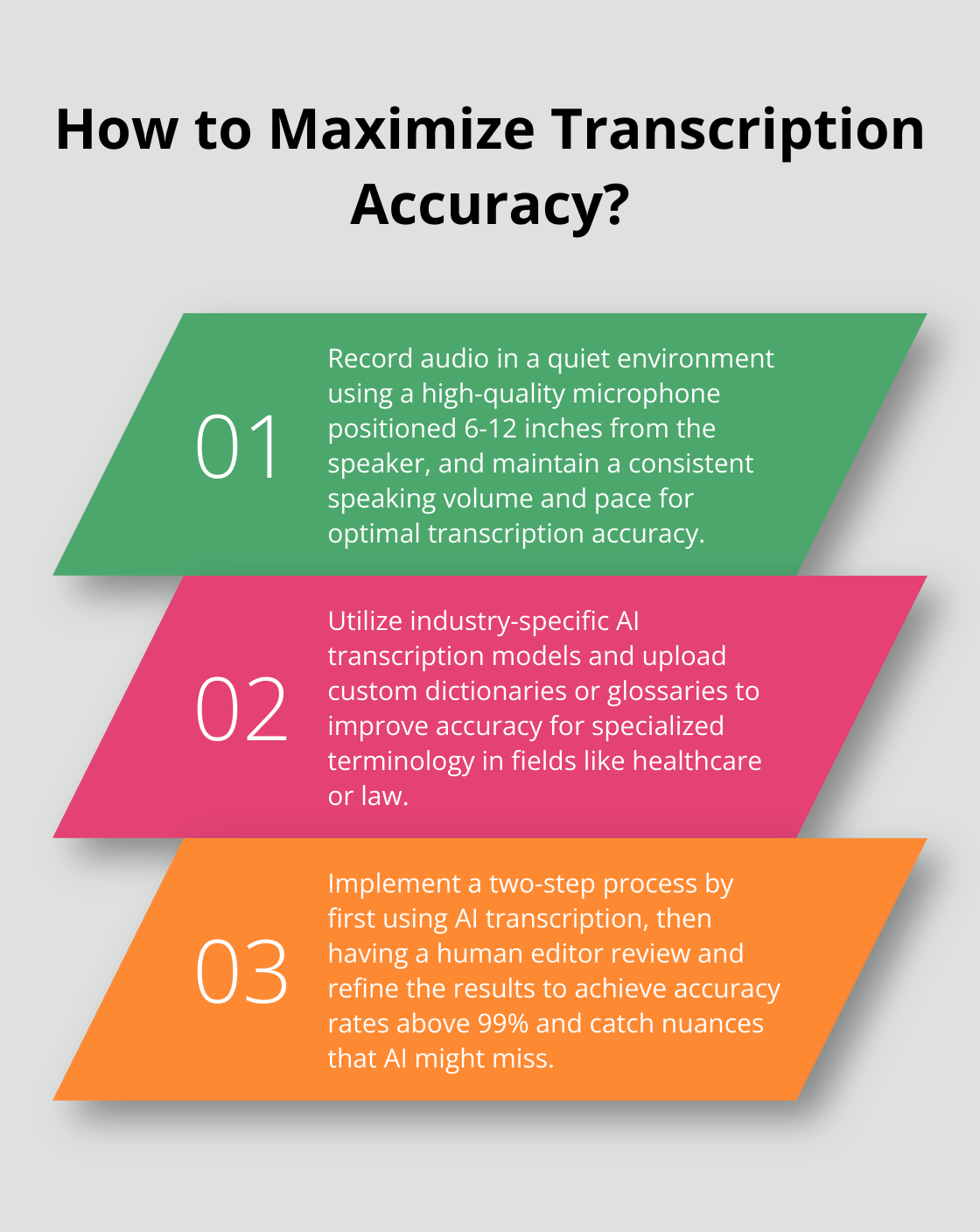
AI technology continues to advance, promising more impressive capabilities in the future. Improved natural language processing will lead to better understanding of context and nuance. Enhanced speaker recognition will make multi-speaker transcriptions more accurate and easier to follow. Real-time transcription capabilities will continue to improve, opening up new possibilities for live captioning and instant documentation.
Not all AI transcription solutions offer equal results. Choosing the right tool for your specific needs can make a significant difference in your outcomes. For those in the medical field, ScribeJoy offers a powerful solution that combines AI transcription with human verification to achieve high accuracy in medical documentation. This approach allows healthcare providers to focus on patient care while ensuring reliable and compliant transcriptions.
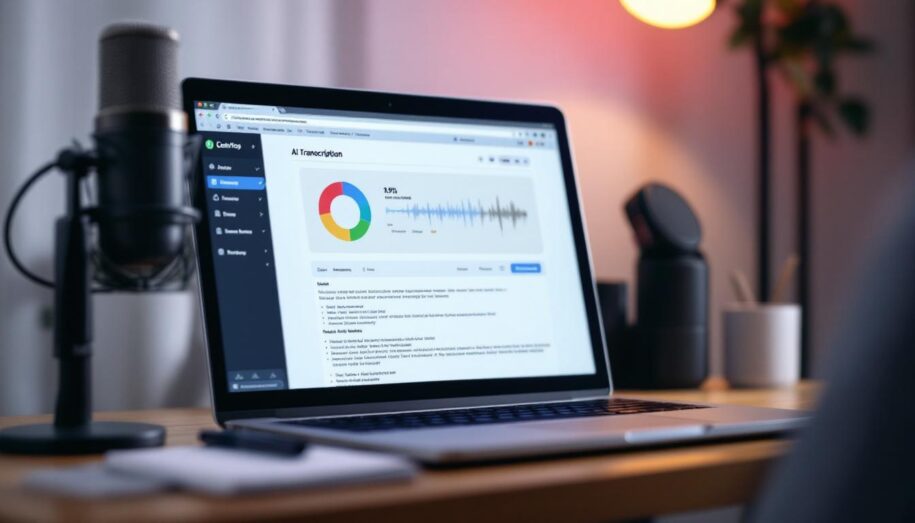
Leave a Reply
You must be logged in to post a comment.